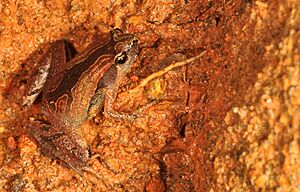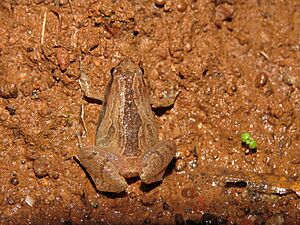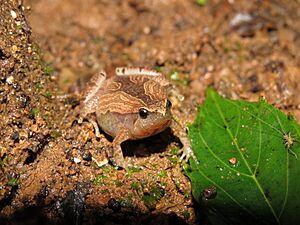Microhyla sholigari facts for kids
Quick facts for kids Microhyla sholigari |
|
|---|---|
 |
|
| Conservation status | |
| Scientific classification |
The Microhyla sholigari is a tiny frog found only in southern India. It's a type of microhylid frog. This frog was first found in the Biligirirangan Hills in Karnataka. It's named after the Soliga people who live in those forests.
At first, people thought this frog was very rare. It was known only from a few spots in the Western Ghats. Because of this, it was listed as an Endangered species. But a recent study found many more of these frogs. They found them in 15 different places in the central Western Ghats. They even saw them near the Bannerghatta National Park in Bangalore.
This new study helped scientists learn more about the frog. They took new pictures and recorded its calls. They also looked at its threat level again. Now, they suggest it should be a Least-concern species. This is because it is not as endangered as once thought.
Contents
What Does the Sholigari Frog Look Like?
The Microhyla sholigari is a small frog. Adult males are about 1.6 centimeters long. Females are a bit bigger, around 1.7 to 1.9 centimeters long. This frog has a pointy snout. Its snout sticks out past its lower jaw.
The frog's eardrum, called the tympanum, is hard to see. Its head is wider than it is long. The throat is a light brown color with some darker brown spots. The tips of its fingers and toes are wide. It has only a little bit of webbing between its toes.
The skin on its back is smooth. It has small bumps, called tubercles, which get thicker near its rear end. The skin on its back is brown. The small bumps are pale red. Its front legs are reddish-brown with black stripes. The sides of its body are grayish-black. This color fades as it gets closer to its groin area.
When the frog is alive, it is mostly brown. It has clear black markings on its back, hands, feet, and sides. There is a dark, three-leaf shape on its back. This pattern goes from between its eyes to its rear end. It looks a bit like a sword with a handle guard.
The Frog's Eyes and Sounds
The frog's eyes have a golden-yellow color. They have brown spots and a black pupil. The sounds M. sholigari makes to attract mates are like a sharp 'Zeeeeee…..Zeeeee…..Zeeeee…'. Many frogs call together in a chorus. Each call lasts about 0.76 seconds.
These calls have 52 to 67 pulses. The main sound frequency is about 3596 Hertz. This species is genetically similar to another frog called M. laterite.
Where Does the Sholigari Frog Live?
The Microhyla sholigari is a land-dwelling species. It is often found in and around places where people live. It also lives in open areas of forests and near ponds. These frogs usually stay in areas with thick clumps of grass.
They make their calls from 6 PM to about 11 PM. This happens during the months of June to October. They lay their eggs in shallow water. They might also breed in slow-moving streams in forested areas. Their calls can overlap with other M. sholigari frogs. They also call at the same time as ground crickets.
This frog is currently threatened by habitat loss. This means their homes are disappearing. Today, this is mostly due to cities growing bigger. In the past, it was also caused by farms expanding and people cutting down trees.
Where Can You Find the Sholigari Frog?
The Microhyla sholigari is found in a wide area of south India. The total area where they live is about 28,304 square kilometers. These frogs are very common in some places. For example, in Bisle and the Biligiri Rangaswamy Hills Tiger Reserve. You can also find them near Shivanalli, Bangalore, Karnataka. In these spots, there can be over 50 calling male frogs in a 100 square meter area.




